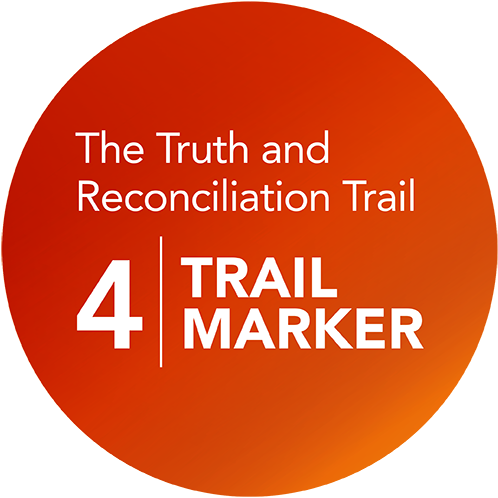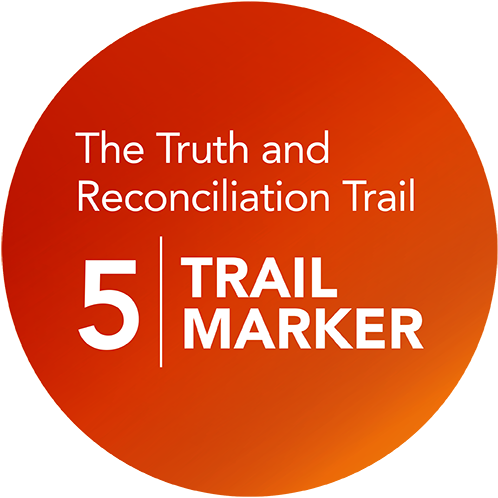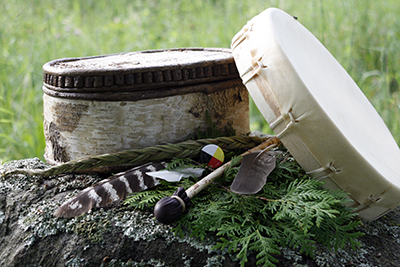Exploration to Colonization
Truth and Reconciliation Trail | Marker 4
Imagine, vibrant Indigenous Nations across Turtle Island (North America) living with abundance, well established in areas such as resources, land stewardship, trade, food, education, spirituality, and self-governance. This was life prior to first contact with Europeans who arrived here relying on Indigenous People for survival and trade. Indigenous Nations eventually became obstacles to colonial expansion aimed at seizing land for European settlement and controlling resources. This would have devastating impacts on Indigenous People, including the Anishinaabeg, who were displaced from their traditional lands and forcibly assimilated into the encroaching Euro-Christian society.
Exploration
Vikings were estimated to have landed in 793 A.D. Oral history tells of this first contact. Recorded history shows that the Vikings settled on the coast of Newfoundland but were driven out by conflict with the locals in the late 1300’s. Columbus landed in the Caribbean for the first time in 1492, which began the voyages from Spain and England to the New World bringing with them, conflict, disease and slavery.
Not all the newcomers were here for war and slavery. There was a time of trade and negotiations between Nations. Europeans entered official Treaties with Indigenous Nations, some dating back 400 years. They permitted access to pass through North America and defined a code of conduct. This model was based on being equals to each other with governance principles of peaceful co-existence, respect and sharing of resources between diverse peoples.
In the beginning Indigenous People were viewed by explorers as critical for survival and trade. However, as time passed, they became increasingly seen through the colonizer lens as impediments to land and resources.

Colonization
Eventually Europeans would use the relationship they built with Indigenous People based on trade to steal land. There are two strategies that were used to steal the land from Indigenous People: the Doctrine of Discovery and terra nullius.
The Doctrine of Discovery stated that land can be stolen from Indigenous nations across the world in the name of Christianity. If land was vacant, it can be claimed. Many Europeans viewed land that were owned and actively utilized by Indigenous People as “vacant” if not being used according to European law. Because Indigenous People were non-Christian, non-European, taking their land was justified.
The notion of terra nullius, meaning empty land in Latin, was also used to justify the theft of Indigenous land. If the land was uninhabited, it was free for the taking. Again, since Indigenous People were non-Christian, they were considered nonhuman, and their land was considered empty and taking it was justified.
These two strategies were used to justify violently displacing Indigenous People from their ancestral homelands over hundreds of years. In Canada, it allowed for the Crown to grant land to its colonial interests. Today, Crown Land makes up over 85% of Canada’s land mass despite the Crown’s Royal Proclamation of 1762 which initially recognized First Nations rights in Canada. The Proclamation, a document that is still referenced in Canada today, recognized Indigenous People as the owners of the lands. Despite this, Indigenous rights to their land continue to be ignored by the Canadian state.
It’s important to view colonization as an ongoing system. Colonization is not an event of the past. Colonization continues as an unfinished and incomplete project, continually impacting the lives of Indigenous People across Canada today.
An example of this is the Indian Act, Canada’s oldest and most amended piece of Canadian legislation. The Act was used to give the Government of Canada complete control over the lives of First Nations people. It has contributed to several violations of human rights by Canada’s own standards and has been considered discriminatory and oppressive towards First Nations people.
The most destructive policy included the Indian Act occurred in 1920, when it became mandatory for every Indigenous child to attend the Indian Residential School system.
Although this, and many other policies, have been amended in the Indian Act, the Act itself is legislation still used in Canada to today.
Gathering truth
On colonization
Reconcili-ACTION
Georgian College has 6 Historic Treaties in its catchment area. Historic treaties were signed across Canada between 1701 and 1923. They were treaties made between First Nations and the Crown. During the signing of these treaties, many First Nations leaders believed they were securing a prosperous future for their people (such as accessing education, health care, and economic wealth). Many First Nations leaders were coerced into signing the treaties, whether they were lied to or forced to sign in order to ensure the survival of their people. The Crown’s main goal was always to acquire land and resources and displace Indigenous People from their land.
Explore the 6 Historic Treaties in Georgian College’s catchment area. Choose one treaty to research. In your research, ask yourself:
- What’s the history of this treaty? Why was it created?
- How did the Crown use this treaty to steal land and resources from Indigenous People?
- What were some of the past and present impacts of this treaty on Indigenous People? What are some of the impacts of this treaty on the land itself?

